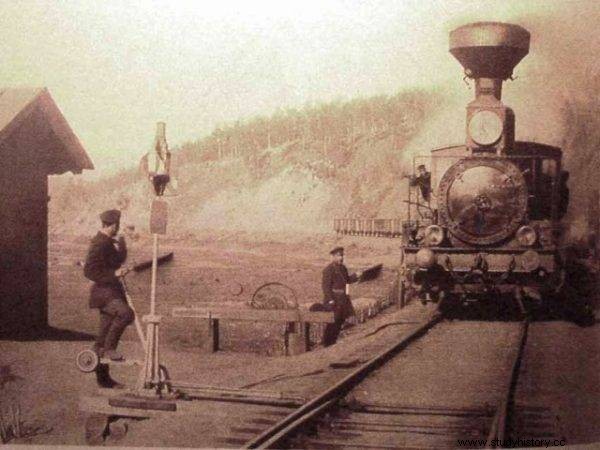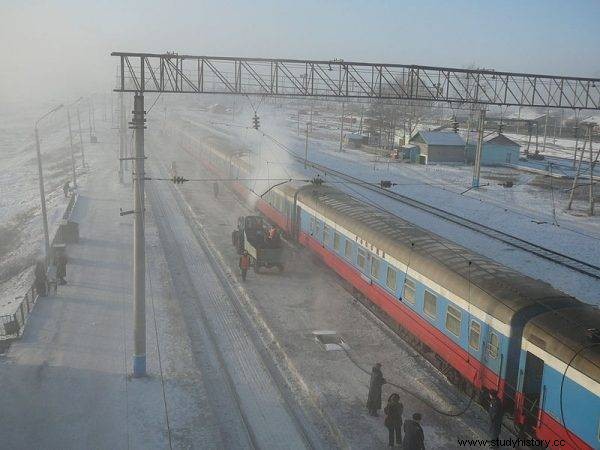The Trans-Siberian Railway is one of the greatest achievements of Russian technical thought and the longest railway line in the world, measuring as much as 9289 km. It starts in Moscow and ends in Vladivostok, connecting the European part of Russia with Siberia, the Urals and the Far East.
In fact, only the eastern part of the main road can be called the Trans-Siberian Railway - between the city of Miass in the Chelyabinsk Oblast and Vladivostok (approx. 7 thousand km long). In 1905, the construction of this section enabled the first-ever rail journey from Western Europe to the coast of the Pacific Ocean. This, in turn, allowed the Russians to use the natural resources of Siberia and the Far East, and to transfer their troops towards the Far East (the last one took place during the Russo-Japanese war).
Innovative methods
Work began on May 19, 1891. The Great Siberian Road, as the Trans-Siberian Railway was called in tsarist times, was built in parallel at its two ends, i.e. from Vladivostok to Khabarovsk in the Far East and from Chelyabinsk to Novosibirsk, as an extension of the then existing Moscow-Chelyabinsk line. The works were carried out simultaneously on many episodes.
In 1901, there were only two sections left to fully connect Moscow with Vladivostok. One of them was the 330 km long Krugobaykal Railway which provided a bypass of Lake Baikal from the south, i.e. from Irkutsk to the town of Mysovsk. It was an extremely difficult section, because the shores of the lake consisted of steep, almost vertical walls, located 400 m above the water level . The harsh conditions forced the builders to create a route in tunnels or on artificial shelves carved in rocks. The work was carried out by hand, with the use of pickaxes. This would not be surprising if not for the fact that the workers with pickaxes in their hands had to use ropes to glide down steep slopes due to the rock arrangement.

Laying the tracks in 1898
But perhaps the most interesting solution during the work on the Krugobajkalska Railway was the rail-ferry crossing. Before the section to bypass Lake Baikal was built, in the spring and summer period its shores were connected by two ships - icebreakers purchased from the Scottish Armstrong &Co. One of them began to run on April 24, 1900, and the other - on August 1 of that year. On the other hand, in winter, railroads were laid on the frozen surface of the lake, and the wagons were pulled on them individually, using horse traction.
On October 1 (September 18), 1904 the first train passed the Krugobajkal Railway and the route was put into service. But the authorities did not give up the ferry railway crossing also in the winter of 1904–1905. It was used in parallel with the newly opened route, because due to the poorly developed railway network, the Russians had a problem with transporting weapons and soldiers to the Far East. It is estimated that during the Russo-Japanese war as many as 2,000 people were transported to the front in this way. wagons for which approx. 3 thousand. horses.
A showpiece of Russian railways
Trains on the Moscow-Vladivostok route began to run in 1916. At that time, the drive from Moscow to Vladivostok took two weeks. Currently, the journey to the Far East takes 143 hours and 20 minutes, and in the opposite direction - 145 hours and 27 minutes. This means that passengers spend 6 days on the train!
There are many trains on the Moscow-Vladivostok route, but Russia's real pride is the "Rossiya" company depot. It departs from the Jarosławski Railway Station in Moscow, traverses 7 time zones and 19 regions, stops at 59 stops including in the cities of Perm. Yekaterinburg, Omsk, Novosibirsk, Krasnoyarsk, Irkutsk, Ulan-Ude, Chita, Birobidzhan, Khabarovsk, Ussuryjsk.
The "Rossija" train was launched in 1966. Originally, its wagons were painted cherry red, then the color was changed to red and green. As "Rossiya" is a showcase of the local railway, since 1993 the train has the colors of the Russian flag, and the wagons used in it are of domestic production (Mechanical Plant in Tver). The squad was supposed to be the face of the Soviet state railways, therefore, since its appearance, a strict process of selecting personnel was carried out. For example, conductor positions are hired by people with several years of experience, exceptional interpersonal qualifications, fluent in English . "Rossiji" employs a technician, the proverbial "handyman", who goes around the train three times a day and repairs any faults.

A 1903 train at the Chilok station
Passengers can choose from three types of carriages. The most popular of them is the wagon płackartny - consisting of nine non-lockable stalls, which are a sort of compartment with 2 berths at the top and 2 at the bottom. In addition, there are two more sleeping shelves in the corridor - upper and lower. The second one can be quickly transformed into a table with two seats. 54 passengers can travel, the ticket costs 18,144 rubles (about 1000 PLN) . The car has 2 toilets, a samovar with boiling water and electric sockets. Passengers receive bed linen for an appropriate fee. The openness of the stalls favors the integration of travelers.
Better conditions are offered in carriages buyers - from the word "kupe", which means lockable compartments. Each of them is designed for 4 people. The car can accommodate 36 passengers. The journey costs 29,366 rubles (approx. PLN 1,700). Passengers can use a TV set in each compartment, bed linen included in the ticket price, a button to call the conductor, the possibility of closing the compartment with an electronic card. Coffee and tea are served free of charge.
The SW carriages are the most comfortable . They have large, double compartments with two lower berths. Similar to buyers Each compartment is equipped with a TV set, but travelers are also entitled to meals provided by the conductor. Each passenger receives free slippers, toiletries, press, towel.
A journey with a metaphysical dimension
Who decides to ride this train? According to members of his staff, they are military business travelers, especially privates going on vacation or returning from vacation, which the military pays for their journeys. Among the passengers there are many railwaymen entitled to large concessions. There is no shortage of people who are afraid of flying. There are also Russians who want to get to know their own country (probably according to the opinion of the Tsarist Prime Minister Sergei Witte that every true Russian patriot should make a trip on the Trans-Siberian Railway) and foreigners for whom the ride on board "Rossija" is an attempt to get to know Russia. The most famous passenger on this train was David Bowie, afraid of flying in an airplane .

"Rossija" at -40 ° C in Mogotscha
As there is Wi-Fi on the train, foreigners traveling there are eager to share their impressions and photos on blogs, Instagram and Facebook. Most of them express the opinion that 6 days on the train allows them to calm down, take a distance and understand themselves and the world around them . Having traveled the Moscow-Vladivostok route, a certain Julia from Copenhagen drastically changed her life - she quit her hated job and moved to another country. British Cathy Glass and her boyfriend spent Christmas on board the Rossija. During the trip, the couple read "War and Peace" by Leo Tolstoy and watched Soviet and Russian films.
Sources:
- У иностранцев появился новый тренд:путешествие по Транссибу в плацкарте РЖД (Странно, во вонто, https://www.adme.ru/svoboda-puteshestviya/u-inostrancev-poyavilsya-novyj-trend-puteshestvie-po-transsibu-v-plackarte-rzhd-stranno-no-oni-v-vostorge-2022615 /? fbclid =IwAR0TBHWWG5SI5FlD8UGepm86uDAz1FzoUtCfq4gsUFtrjv6Pocc6UkUzh-Q ( accessed on 28/11/2021)
- Wiernicka V., Secrets of Russian Railways . Łódź, 2019
- Documentary film "Транссиб 9288. Транссибирская железнодорожная магистраль", Телеканал "ВМЕСТЕ-РФ"
